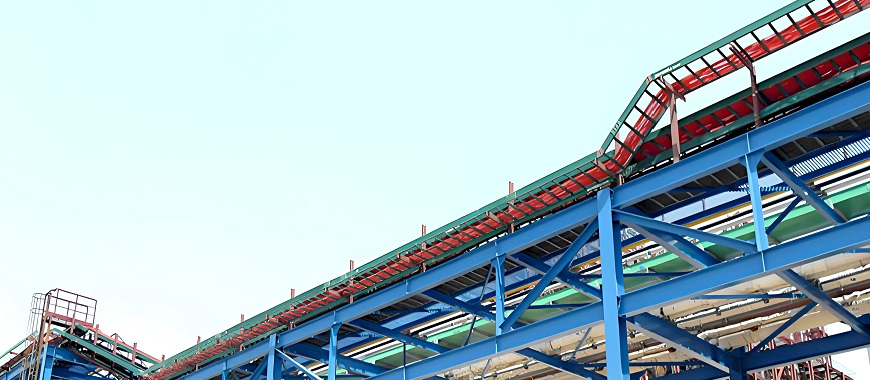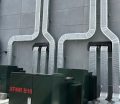
A separator cable tray is a specialized component used in cable management systems to organize and segregate different types of cables within a single tray. These trays typically come with built-in dividers or separators that create separate channels for power, data, and communication cables, ensuring that each cable is routed independently to avoid interference, tangling, and damage. This separation not only prevents cables from rubbing against each other but also helps maintain a clear and structured path for cables, which is particularly important in complex, high-density installations. In industrial, commercial, and telecommunications settings, separator cable trays play a critical role in ensuring safety, improving cable performance, and making future maintenance or upgrades easier and more efficient.
Why Use Separator Cable Trays?
Benefits of Using Separator Cable Trays
A separator cable tray offers numerous advantages that enhance the overall functionality and safety of cable management systems. Here are some of the primary benefits:
- Improved Cable Safety: By keeping different types of cables, such as electrical, data, and communication cables, separated, these trays reduce the risk of short circuits, electrical fires, and interference, which directly enhances cable tray safety. For example, power cables that carry high voltage will not interfere with low-voltage data or telecom cables, ensuring safer system operations.
- Enhanced Organizational Efficiency: With cables neatly organized and separated, the system becomes more manageable, reducing clutter and making it easier to identify specific cables when needed. This organization is particularly crucial in large installations where numerous cables are used for various purposes.
- Flexibility for System Changes: Separator cable trays allow for easy reconfiguration of cable layouts, making it possible to add or move cables as the system expands or changes. The ability to modify cable routes without major disruptions is an advantage in fast-changing environments like data centers or manufacturing plants.
- Easy Maintenance and Upgrades: With cables clearly separated and accessible, maintenance crews can perform repairs, upgrades, or troubleshooting more efficiently. Technicians can quickly identify faulty cables or areas in need of attention without disturbing the entire cable system.
- Longer Cable Life: Separators prevent cables from rubbing against each other, minimizing wear and tear. By reducing the friction between cables, cable separation in cable trays help preserve the integrity of the insulation, which in turn extends the overall lifespan of the cables.
Types of Separator Cable Tray Dividers
Cable Tray Divider Requirements
When selecting a separator cable tray, it’s important to consider specific industry standards and regulations for divider requirements. These include:
- Load-Bearing Capacity: Dividers must be able to support the weight of the cables without bending or warping, ensuring long-term stability and safety.
- Fill Percentage: The proper fill percentage (how much of the tray is filled with cables) is essential for ensuring adequate airflow and heat dissipation, preventing overheating of cables.
- Safety Considerations: Dividers must comply with relevant safety standards, including preventing cables from becoming damaged or exposed to harsh environmental conditions.
Selecting the correct divider for your system ensures the tray will operate efficiently and meet regulatory requirements.
Aluminum Cable Tray Divider
Aluminum is a widely preferred material for cable tray separation because of its excellent combination of lightweight construction and exceptional corrosion resistance. This makes aluminum dividers ideal for use in challenging environments, such as data centers, telecommunications facilities, and industrial settings, where high humidity or exposure to chemicals is common. The durability of aluminum ensures that the dividers maintain their integrity over time, even under harsh conditions. Additionally, aluminum dividers provide great flexibility in cable tray installations. They can be easily adjusted or modified to accommodate changing cable routing or evolving system requirements, making them a versatile solution for long-term cable management. The ease of installation and modification helps businesses maintain organized, efficient cable systems while adapting to technological advancements or growing infrastructure needs.
Cable Tray Divider Strip
A separator cable tray often includes divider strips, which are smaller, modular components designed to create distinct channels within the tray for organizing different types of cables. These divider strips are available in various materials such as galvanized steel, aluminum, and plastic, allowing for customization based on environmental conditions. Divider strips not only enhance the organization of cables but also provide additional structural support, helping to prevent cables from sagging or shifting during both installation and operation. They are particularly valuable in maintaining cable integrity over time, especially in systems that require high-density cable management.
Top Materials for High Voltage Cable Tray Applications
Applications of Separator Cable Trays
Telco-Style Cable Runway
Telco-style cable runways are specifically designed for managing large volumes of cables in telecommunication environments, where organized cable routing is crucial to system performance. These cable runways often feature separator dividers to effectively manage and segregate power, data, and signal cables. By preventing cross-talk and electromagnetic interference (EMI) between different types of cables, separator cable trays in Telco-style runways help ensure the smooth operation of communication systems. This setup enhances signal integrity and minimizes the risk of signal degradation, which is critical in high-demand telecommunication applications. Additionally, using cable tray separation requirements in these runways contributes to a more organized and accessible layout, simplifying both maintenance and future upgrades, and improving overall system reliability.
Cable Tray Ladder
A separator cable tray installed in a ladder-style design is an optimal choice for industrial environments that handle heavy-duty and high-capacity cables. The open, ladder-like structure allows for excellent air circulation, which is essential for dissipating heat from cables, thus preventing potential overheating and ensuring long-term reliability. The addition of separator dividers within the ladder tray helps organize the cables into clearly defined channels, preventing tangling and cross-interference. This is particularly beneficial in environments where different types of cables—such as power and control cables—need to be kept separate. The use of separator cable trays in ladder-style installations ensures that cables are securely positioned, minimizing damage and facilitating easy maintenance and troubleshooting. This type of system is ideal for managing large, bulky cables over long distances, helping to maintain cable integrity and promote the efficient operation of industrial systems.
Key Benefits of Using Separator Cable Trays
Enhanced Cable Organization
A separator cable tray helps maintain an organized cable management system by keeping each cable in its own dedicated channel. This structure prevents cables from tangling or becoming damaged, which is particularly important in environments with high cable density. Additionally, the organized layout simplifies cable identification and tracing, making troubleshooting and future upgrades more efficient. By clearly separating cables, the tray ensures that power, data, and communication cables remain distinct, minimizing the risk of interference and signal degradation. This level of organization not only enhances system reliability but also makes maintenance and expansions more manageable over time.
Safety and Compliance
Using separator cable trays is essential for ensuring compliance with safety standards and regulations, such as the National Electrical Code (NEC). By keeping power cables separate from low-voltage data cables, these trays help reduce the risk of electrical hazards, including short circuits, fires, and electromagnetic interference (EMI). This separation not only enhances the safety of the installation but also improves the overall efficiency of cable management. The use of discrete cable tray makes it easier to meet regulatory requirements, providing a safer, more organized, and reliable solution for both industrial and commercial environments.
Ease of Maintenance and Upgrades
One of the key advantages of separator cable trays is that they simplify ongoing maintenance and system upgrades. The clear separation of cables allows technicians to easily identify individual cables for replacement, repair, or modification. Furthermore, the modular design of many separator cable trays allows for the easy addition of new cables, making the system adaptable to future needs.
- Better Troubleshooting: With cables neatly organized and easily identifiable, troubleshooting becomes faster and less disruptive. Technicians can quickly locate the faulty cable, reducing downtime and improving system reliability.
- Reduced System Downtime: The easy accessibility of cables in a well-organized separator cable tray minimizes the time required for maintenance or system modifications, ensuring that any necessary work can be completed with minimal disruption to operations.
Cable Tray Divider Price Guide: Find Best Deals
Choosing the Right Separator Cable Tray
Selecting the Best Separator for Your Application
When choosing a separator cable tray, it’s important to take into account the specific needs of your installation. Consider factors such as:
- Cable Type: Ensure the dividers are appropriate for the types of cables you are using (e.g., power cables, data cables, or telecom cables).
- Environmental Conditions: For wet, humid, or harsh environments, consider materials such as galvanized steel or aluminum that can resist corrosion.
- Available Space: Consider the available space for the cable tray installation. In smaller or confined areas, more compact separator systems may be necessary.
Future Trends in Cable Tray Systems
As industries like telecommunications, automation, and robotics continue to expand and evolve, the need for adaptable and efficient cable management solutions is becoming more critical. The future of separator cable trays is centered around their ability to provide flexible, scalable systems that can easily adapt to growing infrastructure demands. These systems will need to accommodate new types of cables, handle increased data traffic, and support emerging technologies like the Internet of Things (IoT), 5G networks, and smart manufacturing. As businesses scale, cable management systems must be able to support higher volumes of cables, with the flexibility to quickly reconfigure pathways to match the dynamic needs of the facility.
The trend towards modular and customizable separator cable trays reflects this shift towards more versatile designs. These systems will incorporate features such as adjustable dividers, easily expandable tray lengths, and advanced materials that allow for increased strength and durability. Moreover, as industries become more reliant on data and automation, cable trays will increasingly need to support high-performance cables, which require better organization and protection against interference. The future of cable management will also prioritize sustainability, with an emphasis on eco-friendly materials and energy-efficient designs that reduce environmental impact while enhancing overall system performance. These evolving trends highlight the growing importance of designing cable tray systems that not only meet current needs but can also be reconfigured to accommodate future technological advancements.
Benefits of Choosing European Cable Tray for Industrial Projects
FAQs about Separator Cable Tray
When installing a cable tray system, separation requirements refer to the physical and electrical spacing between different types of cables to ensure safe and efficient operation. The National Electrical Code (NEC) outlines specific guidelines for these separations. The primary purpose of these separation requirements is to reduce the risk of electrical interference, prevent fire hazards, and ensure safe operation within the tray.
Key separation requirements for a cable tray include:
Separation of Power and Low-Voltage Cables: Power cables (carrying high voltage) should be separated from low-voltage cables (data, telecom, etc.) to prevent electromagnetic interference (EMI) and reduce the risk of short circuits.
Separation for Heat Dissipation: Adequate spacing between cables allows for airflow, preventing heat buildup that could damage the insulation or cables themselves.
Physical Separation for Safety: Cables that could potentially cause fire hazards should be separated by fire-resistant materials or barriers. This is especially important in environments where hazardous materials are present.
Maintaining proper separation also facilitates easier identification of cables for maintenance and troubleshooting. Depending on the system’s complexity and regulatory codes (such as NEC), you may need to use physical dividers or barriers within the tray to meet these separation requirements.
Cable trays come in various designs to accommodate different needs and installation environments. The three main types of cable trays are:
Ladder Cable Tray:
The ladder-style cable tray is the most commonly used in industrial applications. It consists of two side rails connected by rungs, similar to a ladder. This design allows for maximum airflow, which helps with heat dissipation and cable longevity. Ladder trays are particularly effective for supporting heavy cables and offer easy access for installation, inspection, and maintenance.
Solid Bottom Cable Tray:
A solid bottom tray is a continuous, flat surface that provides a stable, secure channel for cables. This type of tray is ideal for installations where cable protection is a concern, as it prevents dirt, debris, and moisture from coming into contact with the cables. However, it offers less airflow compared to the ladder style, so it’s crucial to ensure that proper heat dissipation mechanisms are in place.
Ventilated Trough Cable Tray:
Ventilated trough trays combine the advantages of both ladder and solid bottom designs. They have side rails with a perforated or slotted base, allowing airflow while still providing protection for the cables. These trays are often chosen when there’s a need for a balance between cable protection and ventilation. They are suitable for environments where heat buildup is a concern, but full cable exposure is not desirable.
Each of these tray types has distinct benefits depending on the specific requirements of the installation, including factors like cable size, environmental conditions, and ease of maintenance.
A perforated cable tray is designed to provide a balance of support and ventilation for cables. The tray’s structure consists of a solid side rail with a perforated or slotted bottom, which allows for air to circulate freely around the cables, preventing heat buildup. This is crucial in installations where cables may carry high electrical loads, as excessive heat can degrade the cables’ insulation, reduce their lifespan, and even lead to equipment failure.
The primary purposes of a perforated cable tray are:
Heat Dissipation: The perforations allow air to circulate around the cables, helping to keep them cool and preventing overheating.
Cable Protection: While allowing ventilation, perforated trays also offer some protection against external factors like moisture, dirt, and debris. They help prevent physical damage to cables, especially in environments where cables are exposed to potentially harsh conditions.
Ease of Installation and Maintenance: The open structure of a perforated tray provides easy access to cables, making it simpler to install, inspect, maintain, and replace them as necessary. This makes perforated trays ideal for settings where regular maintenance is required, such as data centers or industrial facilities.
Cost-Effectiveness: Perforated trays typically require fewer materials compared to solid-bottom trays, making them a more affordable option while still providing the necessary protection and functionality.
Due to their versatility, perforated cable trays are widely used in a variety of industries, including telecommunications, data centers, and industrial facilities, where airflow and cable organization are critical.
Yes, you can splice wires in a cable tray, but there are specific guidelines and safety practices to follow when doing so. The ability to splice wires within a cable tray depends on the type of installation and the codes governing electrical safety, such as the National Electrical Code (NEC).
Here are key considerations for splicing wires in a cable tray:
Accessibility: Splices must be accessible for inspection, maintenance, and troubleshooting. The splice should be made in an area where it can be easily reached without requiring disassembly of the cable tray system.
Proper Insulation: The wires being spliced must be insulated correctly to avoid electrical hazards. This typically means using connectors or junction boxes that are rated for the type of wire and voltage in use.
Protection Against Physical Damage: Splices should be protected from physical damage. This could involve placing them in a junction box or using protective covers to shield the splice from external forces like vibrations or impacts, which could cause loose connections or damage the insulation.
Code Compliance: According to the NEC, splices in a cable tray must comply with the relevant wiring methods and installation standards. For example, the splice must be insulated using approved methods and must not obstruct the tray’s primary function of cable management.
No Cross-Cutting of Cables: When splicing, you must ensure that power and signal cables do not interfere with one another, and proper separation must be maintained to prevent electromagnetic interference (EMI).
In short, while splicing wires in a cable tray is allowed, it must be done with care and in compliance with safety standards. Always follow the manufacturer’s instructions and local regulations to ensure that the splice does not pose a safety risk to the system.

As the editor of GangLong Fiberglass, I have years of experience and in-depth research, focusing on cable tray products, fiberglass solutions, and grille systems. I incorporate years of industry insights and practical experience into every content, committed to promoting the progress of the industry. At GangLong Fiberglass, my commitment is reflected in every product, from innovative cable trays to durable fiberglass solutions and sturdy grille systems. As an authoritative voice in the industry, my goal is to provide valuable information to professionals and businesses and promote forward-looking solutions.


